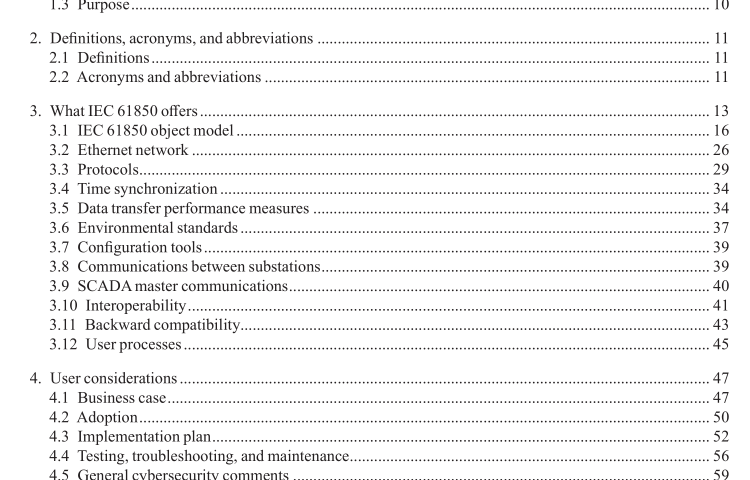IEEE 2030.100-2017 pdf download.IEEE Recommended Practice for Implementing an IEC 61850-Based Substation Communications, Protection, Monitoring, and Control System
3. What IEC 61850 ofers Unlike IEEE Std 1815™ [B63], the IEC 61850 standard is more than just a protocol specifcation. As a standard, it ofers several protocols, project management, conformance testing, object models, confguration language, and environmental requirements, all composing a rich set of tools that could be used by substation design, protection, communications, and supervisory control and data acquisition (SCADA) engineers for the following:
— Implementing substation protection, automation, and control systems — Confguring intelligent electronic devices (IEDs)
— Documenting asset management
— Providing a common language to communicate between the various engineering groups IEC 61850 currently has two editions representing a progression of the standard.
Edition 1 is divided into ten major parts issued between 2003 and 2012. Since 2011, many of the parts are now in Edition 2, incorporating corrections for technical issues (TISSUES), additional logical nodes, and added functionality. Edition 2 expands IEC 61850 beyond the substation boundaries, expanding some parts, introducing new functionality through technical reports (those documents in the IEC 61850-90 series ([B40] through [B45]) in particular), and creating links with other standards. IEC plans to continue this development. Figure 1 shows some of the major functional areas in IEC 61850 and related standards, including a few areas that are currently being worked on.
IEC 61850 covers many functional areas within the power grid. With many optional and mandatory requirements, the user must determine which parts will work best within their system and corporate structure and policies.
This process is not addressed in IEC 61850. Essentially, the IEC 61850 standard addresses the following areas in order to achieve full interoperability and integration of the IEDs:
— Basics required for implementing the standard in IEDs — Confguration of the devices/systems in use
— Communication protocols/standards used
— File formats and data structure standards for information exchange
— Conformity testing to establish successful implementation The following services or functions are incorporated into the IEC 61850 standard:
— SV multicast on the common local area network (LAN) (where Edition 2 provides a profle for a gigabit LAN physical interface) to transmit voltage and current measurements from the instrument transformers to the IEDs (typically process bus)
— Transmission of trip/control/blocking and other critical signals to equipment through the common Ethernet LAN (typically station and process bus)
— Bufered/unbufered report client-server messaging for data exchange (typically station bus)
— Time synchronization of the IEDs using simple network time protocol (SNTP), IEEE 1588 Precision Time Protocol (PTP) (Edition 2) [B58]
— Ethernet Link redundancy via rapid spanning tree protocol (RSTP), high-availability and seamless redundancy (HSR), and parallel redundancy protocol (PRP) for the LAN (the latter two by adopting IEC 62439-3 [B52])
— Cybersecurity via normative and other references to the IEC 62351 [B47] standards — General requirements for hardware design, electromagnatic compatibility, operating temperature range, and shock and vibration withstand capability
— Standardized Extensible Markup Language (XML) fle schema and well defned logical name sets enabling ofine confguring IEDs and a standardized means to communicate between functional engineering groups
— Manufacturing message specifcation (MMS) messaging with substation-wide direct polls or confgured data sets in a client-server arrangement enabling easy confguration of general purpose human machine interfaces (HMIs) and data gateways data exchange
— GOOSE messaging between IEDs enabling de-centralized implementation of substation inter-locking schemes, distributed synch-check for breaker closing, implementation of auto-reclose, and other high- speed schemes (protection or otherwise)
— Implementation of additional protection functionality such as busbar protection using simpler IEDs
Successful implementation of the IEC 61850 standard, other referenced standards, and additional mainstream features has shown the possibility of extending this standard to other areas such as distribution, renewable energy, power plants, and communication beyond the substation. With this in focus, the IEC 61850 standard is expanding to areas outside of the substation to achieve interoperability and integration of the entire power grid. The following lists a few of these areas contained within IEC 61850 and referenced by other standards:
— IEC 61850-7-410 [B29], [B30] provides data models for hydropower plant monitoring and control.IEEE 2030.100 pdf download.IEEE 2030.100-2017 pdf download
IEEE 2030.100-2017 pdf download

Leave a Reply